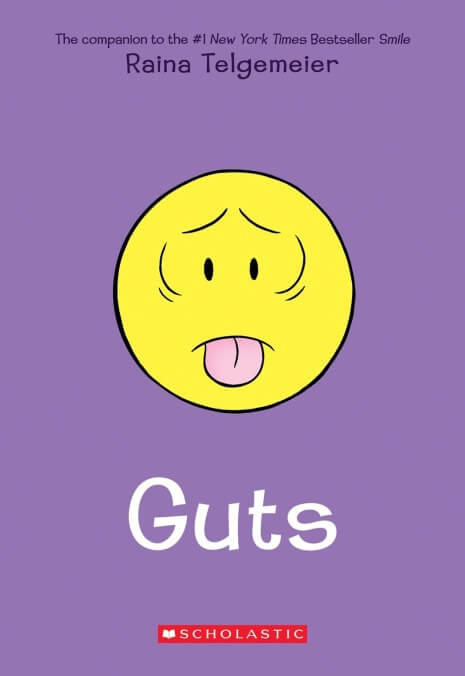
Raina Telgemeier isn’t solely responsible for the explosion of graphic novels in the current literary landscape, but sometimes it feels like the industry revolves around her. It might just be a coincidence that The New York Times revived its Graphic Books and Manga bestsellers list the week after the release of Telgemeier’s new graphic novel, Guts (Graphix), but having a bestsellers list without the top-selling book in the country would emphasize the glaring blind spot in the Times’ books coverage. Guts tops the October list, and previous Telgemeier releases—Drama, Smile, and Sisters—are all still there.
Telgemeier alternates between fiction and nonfiction for her graphic novels, and after 2016’s Ghosts, she returns to graphic memoir with Guts, delving into her experience with childhood anxiety that manifested as nausea and irritable bowel syndrome. Guts takes place before the events of 2010’s Smile, but it deals with more mature subject matter, tackling the topic of mental health. Young Raina’s struggles with anxiety and mental health stigma carry over to people of all ages, and by raising awareness early, Telgemeier is spreading a valuable message about understanding, empathy, and open communication.
The cover design for Telgemeier’s memoirs highlights the value of simplicity, capturing her books’ central themes in altered versions of the basic yellow smiley face design. Smile shows a smiley with braces, Sisters adds a scowling freckled companion, and Guts goes back to a single smiley with its tongue out and a worried expression. These covers pop on bookshelves—the smileys are also printed on the spine—and in digital thumbnails, but they also represent Telgemeier’s experience to elicit a personal response from the reader. This is a technique she explores further within the book when recounting her first sessions in therapy: When she’s unable to use words to describe her feelings, she uses images like a lightning bolt, storm cloud, balloon, heart, crossed fingers, and those ever-useful smiley faces as symbols that invite reader interpretation.
In the past decade, Telgemeier has sharpened her craft to maximize the impact of her storytelling. Her character work is bold and cartoony but still nuanced, bringing depth to personal relationships. Telgemeier’s depiction of her anxiety attacks highlights the expressive power and versatility of the comic-book medium. Her very first attack breaks from the standard panel layouts to put the reader inside her head, using more figurative visual language as Raina falls through the bathroom floor. It’s a dynamic way of depicting the loss of control, and this drastic shift in the visual storytelling creates a strong emotional impression that informs all of her future attacks.
Braden Lamb’s colors play an essential role in evoking Telgemeier’s queasy sensations, and filling the panel with sickly yellow-green accentuates how the feeling pulls her out of the world by overtaking her body and mind. Coloring and lettering work together to reflect Raina’s mindset when she’s overwhelmed by her fears, represented in chaotic arrangements of phrases presented in different typefaces and colors. In these instances, Telgemeier and Lamb make exceptional use of the fundamental elements of comics, showing how page design, panel composition, figure drawing, words, and colors come together to conjure the author’s feeling in its full intensity.

8 Comments
My daughter devours Telgemeier’s books. I think she read Guts like 4 times the week it came out.I think that means the author really knows how to strike a nerve with her audience.
My daughters as well. Especially my 8-year-old. If I had to guess how many times she’s read Sisters, I would say at least 40. And she similarly read Guts multiple times in the days right after we got it.
Shoot…my middle daughter just got this from the library and now I’m worried she’s not old enough for it (she’s nine, albeit a very well read and mature 9 due to having an older sister)
When I read smile I wished I had it when I had my braces on, just reading the description of this makes me wish I had it when I was younger.
She’s good.
Telgemeier alternates between fiction and nonfiction for her graphic novelsThis is exactly why, as a children’s librarian, I hate the term “graphic novel” when “comic” does just fine. There’s literally no such thing as a nonfiction novel, and so many “graphic novels” are memoirs (even going back to Maus) or other works of nonfiction.I mean, the larger issue is that there’s nothing wrong with the term “comic,” but the word is still facing the negative connotations brought by moral panickers over fifty years ago, and it makes it harder to convince parents to let their kids read comics. “Graphic novel” is a neat trick to get the foot in the door, but there’s still an idea that “regular” comics are still bad, which is horrible because they’re an amazing resource for kids and teens (and adults I guess but I don’t care what adults read).So I know it sounds pedantic, but can we call it a comic, please? Or at least a graphic memoir?
Let’s ratchet the pedantic up ten levels: the term “comic book” originated because they were originally reprints of newspaper comics, most of which were humor-based. Since a lot of comics aren’t funny, “comic book” doesn’t cover all the bases either.We’ll have to invent a new word. It all starts here, people!
Enh, my counter to that is that etymology isn’t the same as definition (otherwise “feisty” would mean flatulent and “antisemitic” would mean someone who hates Jews and Christians and Muslims). Technically “graphic novel” goes under the same parameters, but it’s a much newer term that isn’t inseparable from the medium: there are very clear alternatives to it, unlike “comic,” which is the only term anyone uses for what comics are.